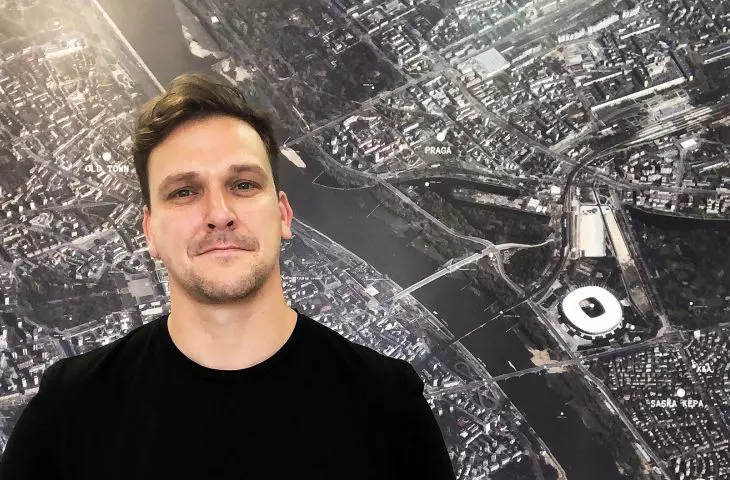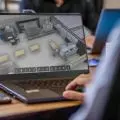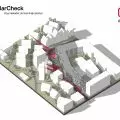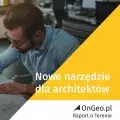Ania: An architect is no longer a demiurge today. How can he be more precisely named? Is he a project manager, leader, team-player, psychologist-therapist?
Maciej Jakub: In Poland we have to define whether an architect is creative or commercial. Abroad it is obvious that an architect is creative. There are special companies for project management. Executive projects in some countries, like in France, don't exist at all or are done for themselves by an executive company. In other places, like in the Czech Republic, the architect is from the vision, the idea, and the construction project is done by a technical company. Until the end, of course, under the supervision of the lead architect. The idea is not to let the subject go, but to let everyone take care of what they can do best. This comes as a shock to many of our countrymen, but when the next big developer sets up his architectural department of fifty-sixty people it is not just to check the work of other independent design offices, but to do their own construction projects as related works under the supervision of the lead architect precisely. In such an arrangement, ostensibly, we are still the general designer, but we also work as a real team-player.
The architect-urbanist should be in part a sociologist, a psychologist. He himself, of course, will not have such knowledge and preparation as professionals in these professions, so he should surround himself with them and use their services.
On the other hand, he should not be a "fixer," someone who can navigate in murky water for his client: guaranteeing the receipt of official decisions or having some influence on them. Like doctors or lawyers, we are a profession of public trust and cannot be combiners. We need to return to the previous canon of creator and beauty.
Food production in the city; greenhouses with cultivation of healthy food in an office park in Mokotow, Warsaw
proj.: © MJZ studio
Ania: You work in an international environment. How can you point out the differences between the condition of a Polish architect and a designer in other EU countries or the United States? It is known that it will come down to generalizations, but if you could outline these differences.
Maciej Jakub: Abroad,it would be unacceptable to copy and re-implement original buildings that exist in another country. You won't find a piece of Mexico's Monterrey, the Netherlands' Rotterdam or France's Strasbourg elsewhere in Europe. And we have all this in Warsaw, Katowice or Wroclaw.
It is not always, in my opinion, a deliberate one-to-one copying. Often it is due to lack of time for research in offices. Inspiration found on the Internet becomes an original work. All because not enough time is spent on the first stage of the project, the concept, or it is done for free. It doesn't cost anything to put the idea together either, and everything somehow falls into place. In my opinion, however, not for the quality of the city.
Ania: And coming back to the architectural profession, can you see differences in condition depending on the area of activity? For example, are designers of public spaces better off than those who create for private clients?
Maciej Jakub: By choice, we do not enter competitions for public buildings, because the conditions there are unacceptable. My last contact with the state administration as a commissioning party or client was a very long time ago. At that time we won a competition for an air traffic control tower at the airport in Lodz, and that body was the State Air Navigation Agency. The process itself was an ordeal. Unlike working with private clients, it is very long and unnecessarily dragged out over time. So are the payments for completed projects. However, they are certain and the architect does not have to deal with collection activities, as is often the case in the private sector.
A building designed in VR with an exhibition in AR; the Science and Technology Center in Opole awarded the German Design Award 2020
proj: © studio MJZ
Ania: Do you use any tools for self-development (such as meditation or other activities)? I'm asking about tools that strengthen mentally and increase mental performance. And also: do you think it is mandatory for architects to take care of the balance between mind and body? As in architecture, pragmatic indicators are taken into account, as well as the more abstract ones.
Maciej Jakub: In addition to boxing, I've practiced aikido, judo, krav maga, capoeira, but also tai-chi, it's very calming. I start my day with coffee and "combing the horse's mane." Now we are learning these meditation techniques with our six-year-old daughter. My father always used to say that you don't necessarily have to be the best at one sport, but to try every sport you can in life.
Ania: How is the condition of the profession affected by the internal organization of architectural offices?
Maciej Jakub: The problem in Poland is not the lack of organization of design offices, creating a hierarchy or abandoning it. There is a lack of real business departments. Ideally, these are parts of offices that employ business, marketing and PR specialists. Boards of directors should not do their jobs. Then perhaps our environment would not be seen as weak and as a party not to be reckoned with in the financial world. I once worked abroad in such a business-development team, and I would like to be able to replicate this in a domestic setting.
Changing the program in the city space; transforming a parking lot into a park in Mokotow, Warsaw
proj.: © MJZ studio
Ania: Does digitization make architects' work easier, or does it drain their batteries and reduce the quality of projects? Do you see yourself designing in AR and VR environments in metavers?
Maciej Jakub: We are already doing this. We created a science center facility in VR, which has an exhibition in AR. We won the 2020 German Design Award for our innovative idea of an object existing in the second dimension.
Metaverse sounds abstract, but for us it can have a practical application - we created a digital copy of a part of Warsaw on the "Unreal" computer game engine. It is fully interactive. We have introduced life into and around the buildings. We have pedestrians with their own AI or drivers moving around the city. It looks like a good game, and can be used, for example, to present relevant data to residents or simulate the development of the metropolis.
I look forward to the further development of machine-learning and AI in the optimization of construction and execution projects. BIM is still too clumsy for me.
Ania: In one of your interviews, for our magazine anyway, you said, "architecture by business and business by architecture." What areas of business and economics will need new architecture in the next five and ten years? What changes will we see in the landscape?
Maciej Jakub: Due to more and more crises and risks, as well as a very rapidly changing economy, the demand for designing adaptable facilities will increase. The norm will be a hotel that can easily be converted into offices. Offices that will become PRS, or short-term rental housing.
We will see the development of technology in agricultural areas, which will then be transplanted to cities to combat food shortages there. This sounds like some distant utopian vision, but we have become experts for the Rome-based UN agency FAO, which deals with food and agriculture worldwide. It has confirmed that these problems are not far off, as they are already occurring in large agglomerations, including China. In some time, as a result of changes and disruptions in the supply chain, they may also occur in Europe.
Ania: The education of architects is probably not keeping up with market changes and the new needs of the profession. But maybe there is something in the area of designer training that can be applied to simply stimulate this better condition of the profession.
Maciej Jakub:There are no simple solutions. There is school and learning. Preferably based on practical knowledge, not outdated theories. We want to get serious about education in this area soon.
Ania: Thank you for the interview.









































